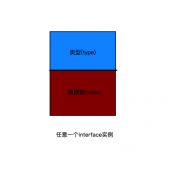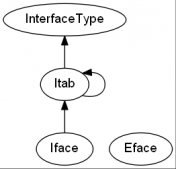一、類型
數組是值類型,將一個數組賦值給另一個數組時,傳遞的是一份拷貝。
切片是引用類型,切片包裝的數組稱為該切片的底層數組。
我們來看一段代碼
|
1
2
3
4
5
6
7
8
9
10
11
12
13
|
//a是一個數組,注意數組是一個固定長度的,初始化時候必須要指定長度,不指定長度的話就是切片了a := [3]int{1, 2, 3}//b是數組,是a的一份拷貝b := a//c是切片,是引用類型,底層數組是ac := a[:]for i := 0; i < len(a); i++ { a[i] = a[i] + 1}//改變a的值后,b是a的拷貝,b不變,c是引用,c的值改變fmt.Println(a) //[2,3,4]fmt.Println(b) //[1 2 3]fmt.Println(c) //[2,3,4] |
二、make
make 只能用于slice, map 和 channel, 所以下面一段代碼生成了一個slice,是引用類型
|
1
2
3
4
5
6
7
8
9
10
11
12
|
s1 := make([]int, 0, 3)for i := 0; i < cap(s1); i++ { s1 = append(s1, i)}s2 := s1for i := 0; i < len(a); i++ { s1[i] = s1[i] + 1}fmt.Println(s1) //[1 2 3]fmt.Println(s2) //[1 2 3] |
三、當對slice append 超出底層數組的界限時
|
1
2
3
4
5
6
7
8
9
10
11
12
13
14
15
16
17
18
19
20
21
22
23
24
25
26
27
28
29
30
31
32
33
34
35
36
37
38
39
40
|
//n1是n2的底層數組n1 := [3]int{1, 2, 3}n2 := n1[0:3]fmt.Println("address of items in n1: ")for i := 0; i < len(n1); i++ { fmt.Printf("%p\n", &n1[i])}//address of items in n1://0xc20801e160//0xc20801e168//0xc20801e170fmt.Println("address of items in n2: ")for i := 0; i < len(n2); i++ { fmt.Printf("%p\n", &n2[i])}//address of items in n2://0xc20801e160//0xc20801e168//0xc20801e170//對n2執行append操作后,n2超出了底層數組n1的jn2 = append(n2, 1)fmt.Println("address of items in n1: ")for i := 0; i < len(n1); i++ { fmt.Printf("%p\n", &n1[i])}//address of items in n1://0xc20801e160//0xc20801e168//0xc20801e170fmt.Println("address of items in n2: ")for i := 0; i < len(n2); i++ { fmt.Printf("%p\n", &n2[i])}//address of items in n2://0xc20803a2d0//0xc20803a2d8//0xc20803a2e0//0xc20803a2e8 |
四、引用“失效”
實現了刪除slice最后一個item的函數
|
1
2
3
4
5
|
func rmLast(a []int) { fmt.Printf("[rmlast] the address of a is %p", a) a = a[:len(a)-1] fmt.Printf("[rmlast] after remove, the address of a is %p", a)} |
調用此函數后,發現原來的slice并沒有改變
|
1
2
3
4
5
6
7
|
func main() { xyz := []int{1, 2, 3, 4, 5, 6, 7, 8, 9} fmt.Printf("[main] the address of xyz is %p\n", xyz) rmLast(xyz) fmt.Printf("[main] after remove, the address of xyz is %p\n", xyz) fmt.Printf("%v", xyz) //[1 2 3 4 5 6 7 8 9]} |
打印出來的結果如下:
|
1
2
3
4
5
|
[main] the address of xyz is 0xc2080365f0[rmlast] the address of a is 0xc2080365f0[rmlast] after remove, the address of a is 0xc2080365f0[main] after remove, the address of xyz is 0xc2080365f0[1 2 3 4 5 6 7 8 9] |
這里直接打印了slice的指針值,因為slice是引用類型,所以指針值都是相同的,我們換成打印slice的地址看下
|
1
2
3
4
5
6
7
8
9
10
11
12
|
func rmLast(a []int) { fmt.Printf("[rmlast] the address of a is %p", &a) a = a[:len(a)-1] fmt.Printf("[rmlast] after remove, the address of a is %p", &a)}func main() { xyz := []int{1, 2, 3, 4, 5, 6, 7, 8, 9} fmt.Printf("[main] the address of xyz is %p\n", &xyz) rmLast(xyz) fmt.Printf("[main] after remove, the address of xyz is %p\n", &xyz) fmt.Printf("%v", xyz) //[1 2 3 4 5 6 7 8 9]} |
結果:
|
1
2
3
4
5
|
[main] the address of xyz is 0xc20801e1e0[rmlast] the address of a is 0xc20801e200[rmlast] after remove, the address of a is 0xc20801e200[main] after remove, the address of xyz is 0xc20801e1e0[1 2 3 4 5 6 7 8 9] |
這次可以看到slice作為函數參數傳入函數時,實際上也是拷貝了一份slice,因為slice本身是個指針,所以從現象來看,slice是引用類型
總結
以上就是這篇文章的全部內容,希望對大家的學習或者工作帶來一定的幫助,如果有疑問大家可以留言交流。












